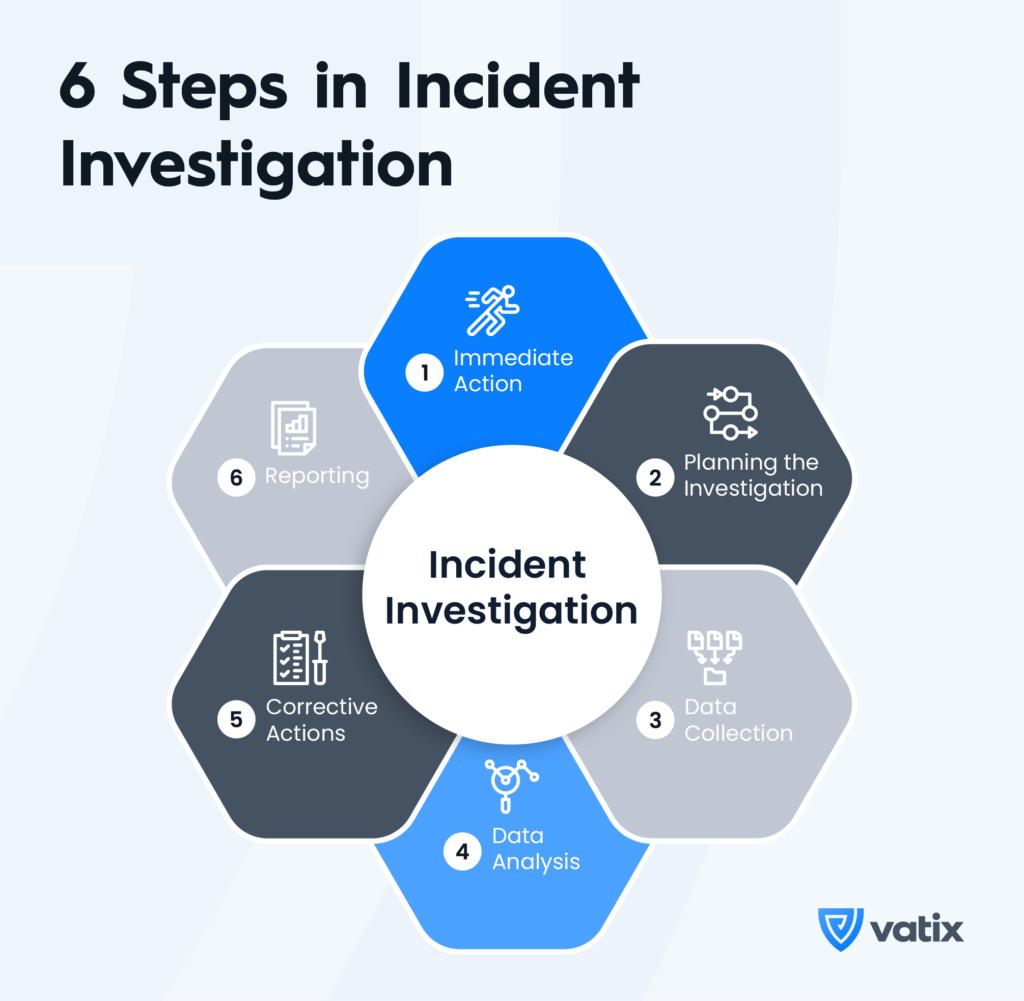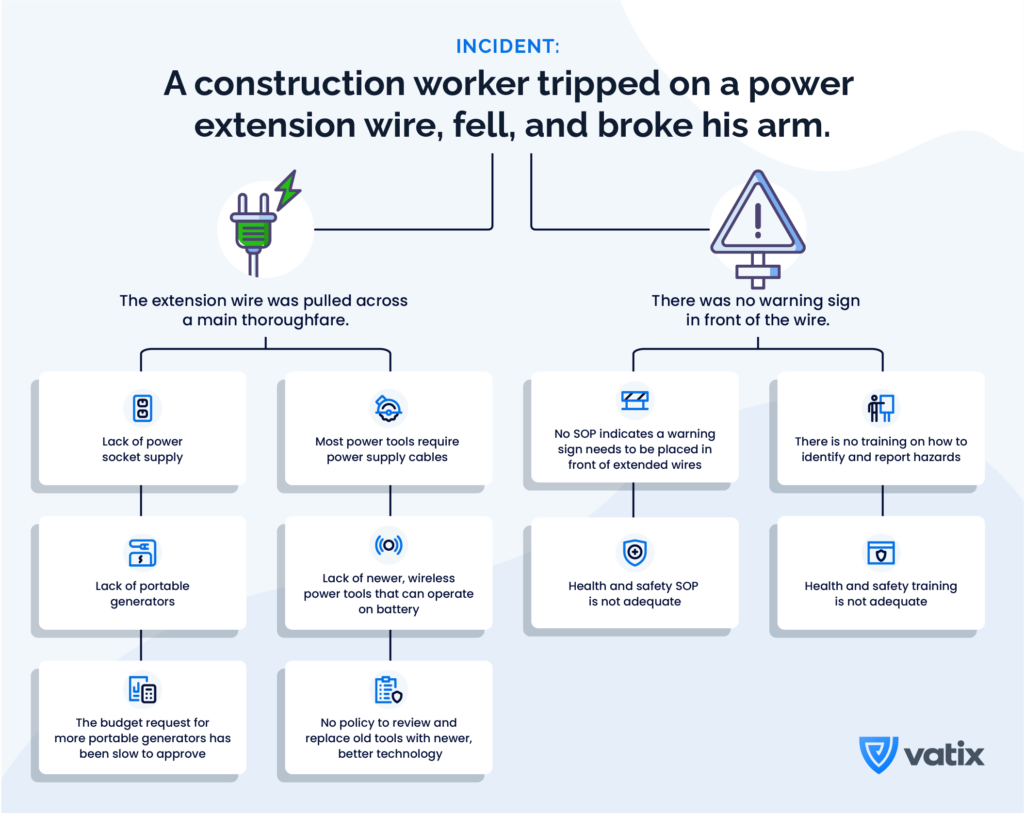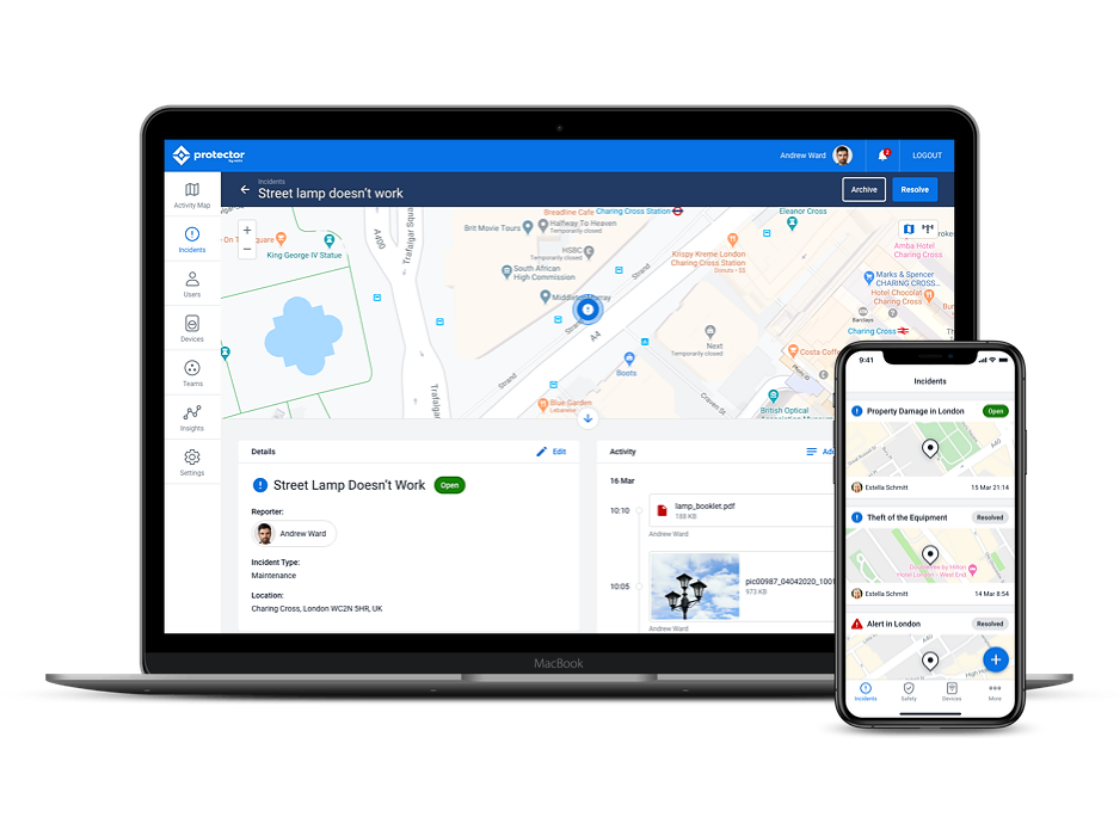Understanding how to conduct an efficient incident investigation is crucial when an unexpected event occurs in the workplace. It involves not only addressing the immediate aftermath but also proactively identifying and rectifying underlying issues to prevent future incidents and promote a safe and healthy working environment.
This guide provides a comprehensive look at the methodologies, strategic approaches, and practical tools essential for mastering effective incident analysis.
Whether you’re a seasoned health and safety manager, a team leader, or a concerned employee, we’ll equip you with the knowledge and skills needed to conduct thorough incident investigations and enhance the culture of safety and vigilance in your workplace.
Understanding Incident Investigations

Incidents in the workplace are any unplanned events that can lead to injury, property damage, or near misses.
Think of incident investigation as workplace safety’s equivalent to detective work. It’s the process of meticulously examining incidents to ensure future safety. Incident reports are the clues and are more than just mere documentation. They hold the key to uncovering the root causes of incidents and are instrumental in preventing similar incidents from occurring in the future.
An effective investigation involves a comprehensive look at the incident’s circumstances, the conditions and events that led up to it, and the factors that played a role in its occurrence. Identifying the underlying causes is vital for the development of effective countermeasures.
Legal and Regulatory Requirements for Incident Investigations

Incident investigation involves adhering to both best practices and legal and regulatory requirements.
In the UK, the Reporting of Injuries, Diseases and Dangerous Occurrences Regulations 2013 (RIDDOR) sets out the legal obligations for reporting specific types of incidents that occur on work premises.
These regulations specify which types of incidents must be reported, the timeframe for reporting, and the potential legal consequences of non-compliance.
For further information on specific RIDDOR reporting requirements and to understand your responsibilities as an employer, be sure to read our in-depth article on the subject.
6 Steps in Conducting an Incident Investigation
Conducting an incident investigation is a systematic process, a step-by-step guide to understanding and learning from workplace incidents. It’s like a roadmap, guiding us from the immediate response to an incident, all the way through to monitoring and reviewing the effectiveness of the corrective actions implemented.

1. Immediate Action
Immediate action is about securing the scene to preserve evidence, providing first aid and medical treatment if necessary, and ensuring the safety of all personnel. This step involves controlling any immediate risks and documenting the scene before any changes occur.
The goal is simple: ensure the safety of everyone involved and preserve the scene as it is for investigation.
Equally important is ensuring employees are trained on how and where to report incidents, promoting a quick and organised response. This knowledge streamlines incident reporting and investigating while simultaneously cultivating a proactive approach to workplace safety.
Looking at incident report examples can help provide valuable insight into the proper way to document and analyse these situations. We recommend downloading our free checklist for a more detailed guide on how to report incidents in the workplace.

2. Planning the Investigation
Planning is crucial for a systematic approach to incident investigation. This step involves several critical actions:
Defining scope and objectives: Clearly outline what the investigation aims to achieve. Determine the extent of the investigation, whether it’s a detailed analysis of a specific incident or a broader evaluation of related safety concerns.
Preparing tools and equipment: If required, ensure all necessary equipment for the investigation is ready. This could include safety gear, photographs of the scene, and any specific technical equipment required for detailed analysis.
Developing a timeline: Create a realistic timeline for the investigation, considering factors like the complexity of the incident, availability of team members, and any external deadlines (like regulatory reporting requirements).
Communication plan: Develop a plan for how findings will be communicated internally and externally, considering the confidentiality and sensitivity of the information.
Effective planning sets the stage for a focused and efficient investigation, enabling the team to work cohesively and systematically towards uncovering the truth behind the incident. It also helps in managing resources efficiently and ensuring that the investigation is completed within a reasonable timeframe, with actionable outcomes.
3. Data Collection

Collecting data for incident investigation involves thoroughly gathering all relevant information about the incident.
This process starts with understanding what happened, including the conditions and actions that led up to the event. Conducting interviews with witnesses as soon as possible is crucial to capture information about the incident and its context while their memories are fresh.
It’s also important to collect or examine any available physical evidence there may be, such as assessing the condition of any equipment involved, checking for any malfunctions or issues, and capturing photos of the scene where the incident occurred.
Visual evidence is often critical in understanding the sequence of events. Incident reporting software can be particularly useful here, particularly by mobile app, allowing for the immediate capture and upload of this visual data for more comprehensive and accurate records.
Reviewing maintenance logs, training records, past incident reports, and any other relevant documentation is equally vital. These records can provide additional context to the incident, revealing historical issues with equipment or gaps in training that may have contributed to the incident.
The amount of time and effort spent gathering information should be proportionate to the severity of the incident. A thorough and comprehensive data collection process leads to a clearer understanding of the incident, ultimately resulting in a more detailed and insightful incident report.
4. Data Analysis
Armed with all the relevant information, we now delve into the analysis phase to identify the patterns, trends, and root causes of the incident.
Identifying Root Causes
Identifying root causes in an incident investigation is much like a detective’s use of a magnifying glass.
It’s all about digging deeper, peeling back the layers to uncover the real culprits of workplace incidents. The slip might have been due to a wet floor, but the root cause could be a missing wet floor sign or a faulty pipe.
Root causes can stem from environmental conditions, individual behaviour and choices, or organisational factors. Identifying these root causes helps to pinpoint exactly what needs fixing, which is the first step towards making informed decisions and changes that enhance workplace safety.
Techniques such as the “5 Whys” and causal trees help investigators delve deeper into the root causes of an incident, moving beyond the immediate causes. Think of these techniques as our detective tools in the world of incident investigation, helping us to connect the dots.
The “5 Whys” Method
This method for root cause analysis involves asking “Why?” five times or more to drill down into an issue. This method helps peel back the layers of symptoms to reach the underlying cause of a problem.
Here is an example of how this works:
Incident: An employee slipped and fell in the warehouse.
Why #1: Why did the employee slip?
Answer: The floor was wet.
Why #2: Why was the floor wet?
Answer: A container of liquid had spilled earlier.
Why #3: Why did the container spill?
Answer: It was accidentally knocked over by a forklift.
Why #4: Why did the forklift knock over the container?
Answer: The forklift was manoeuvering in a cramped space.
Why #5: Why was the forklift operating in a cramped space?
Answer: The warehouse layout had been recently changed, and the new design wasn’t adequately tested for forklift operations.
This example shows how an employee’s slip and fall can be traced back to larger issues such as inadequate planning and testing of a new warehouse layout, emphasising the need for comprehensive safety assessments in operational changes. This is an example of an organisational root cause.
By answering these questions, we are able to accurately identify the root cause, paving the way for implementing effective corrective actions.
Causal Tree
A causal tree is used to evaluate other possible causes that contributed to the incident. It involves mapping out the events leading to the incident in a tree-like diagram, starting from the incident and working backwards to identify all contributing factors and their interrelationships. Each branch of the tree represents a different sequence of events or decisions that led to the incident.
Here’s an example of how a causal tree would look like for a different incident:

This visual representation helps investigators see not just one linear chain of events but all the interconnected factors that played a part.
Causal trees are particularly useful in identifying systemic issues and ensuring no potential contributing factor is overlooked.
This can help organisations uncover additional root causes, thereby facilitating the identification of further corrective or preventive actions.
5. Corrective Actions
Following the investigation, we can plan and implement corrective actions based on our findings. These measures are designed to target the identified root causes, effectively mitigating the risk of a similar incident reoccurring in the future.
Corrective actions could range from changes in procedures, additional training, equipment upgrades, or other safety improvements. Whatever the corrective action, the goal remains the same: to prevent a repeat of the incident and to create a safer workplace.
It is also important to keep a comprehensive record of all corrective actions, including why they were implemented and their anticipated effects. This documentation is key for future reference and ongoing safety management.
Regularly monitoring the impact of these changes is crucial to verify their effectiveness in improving workplace safety.
Ultimately, effective corrective actions are fundamental to learning from incidents. They transform each event into an opportunity for significant improvement, thus strengthening a commitment to safety and awareness within the organisation.
6. Reporting
The final step involves ensuring all the findings, analysis, and corrective actions are properly documented in a comprehensive incident report. This report serves as a tool for communicating the findings to management, staff, and sometimes external bodies.
Clear and concise reporting helps share lessons learned and promotes an environment dedicated to constant development.
Each of these steps is crucial in ensuring that incident investigations are thorough and effective, leading to improvements that enhance workplace safety and prevent similar incidents from occurring.
The Role of Technology in Incident Investigations
The accuracy and quality of input data are critical in any effective incident investigation, highlighting the need for a reliable system for reporting incidents to ensure high-quality data provision.
Digitalising the incident reporting process can significantly enhance the efficiency and effectiveness of incident investigations. The transition from traditional paper-based systems to digital reporting brings notable improvements in speed, accuracy, and ease of analysis.
Vatix’s incident reporting system can help streamline this process by:
Immediate reporting: Employees can instantly report incidents from a computer, tablet or smartphone, avoiding the time-consuming process of filling out and submitting paper forms. This reduces the chances of delayed or overlooked reports while enhancing the quality of the collected data. With the ability to immediately document details and add photos and other attachments from their devices, employees can provide more accurate information, which is crucial for effective investigations.
Customisation options: Tailor incident report templates to fit your organisation’s specific needs, ensuring that all relevant information is captured accurately.
Real-time notifications: Designated managers will be notified immediately when an employee has submitted an incident report. This allows for quicker response times to incidents compared to traditional paper-based reporting, enhancing overall response efficiency.
Action assignment and monitoring: Assign corrective actions to specific individuals through the system, triggering email notifications to those responsible. This functionality enables effective monitoring and follow-up of corrective actions, ensuring they are carried out as planned and contributing to continuous improvements in the workplace.
Advanced analytics dashboards: Our platform gives you access to comprehensive analytics dashboards, offering vital insights into key incident metrics. These dashboards are tailored to meet your specific requirements, providing a clear, user-friendly overview of essential data.
Centralised data repository: Store all incident data, from photos to statements, in one accessible location for organised analysis.

Incorporating incident reporting and management software into a comprehensive incident investigation strategy can help organisations achieve faster and more effective responses to incidents. This approach fosters a positive safety culture, ultimately boosting productivity and reducing the risk of accidents and injuries.
To learn more about how you can tailor our mobile incident reporting software to suit your business needs and enhance workplace safety, talk to our sales team here.
Summary
In conclusion, effective investigations of incidents are essential in enhancing safety in any workplace, focusing on identifying root causes and implementing corrective measures while maintaining compliance with safety regulations.
Following these key steps not only mitigates the risk of future incidents but also fosters a culture of proactive safety and continuous improvement.


